TROBOLO SilvaBlœm
Shapely composting toilet made of wood with HPL finish and optional exhaust system.
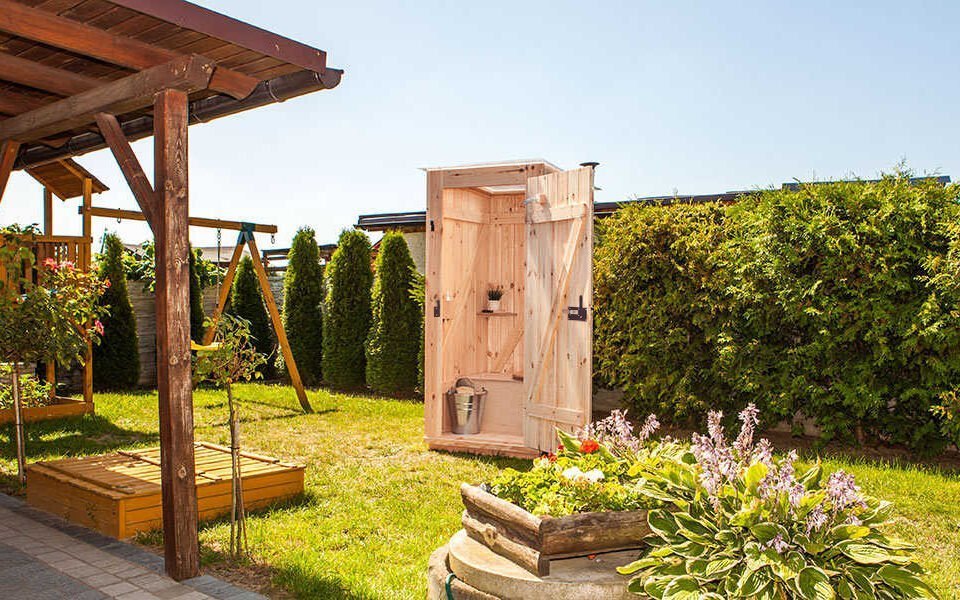
In this guide, you will find information about the functionality, areas of application as well as the benefits and disadvantages of composting toilets.
Composting toilets are not an invention of the present. Rather, outbreaks of disease led to alternative waterless toilet systems for the first time – such as the cholera epidemic in nineteenth-century London which could be traced back to the city’s stinking waste water and cost thousands of lives. Yet ultimately, the ‘water closet’ (WC) caught on (that is, the water toilet as we know it today) and reached even the most remote rural areas by the middle of the 20th century. The concept of the environmentally friendly toilet variant that saved water survived, however, and even sometimes found famous supporters. Thus, the architect Friedensreich Hundertwasser built his own composting toilet in the 1970s and praised its benefits. Nowadays, composting toilets are becoming more widely distributed again due to the increased emphasis on ecological concern, permaculture and the revival of the self-sufficiency scene. The following section shows how a composting toilet works, where it is already being used or in which areas it can be used in and which benefits and disadvantages should be taken into account.
The purpose of a composting toilet can already be derived from its name: it processes human excretions into nutritious compost or humus, a useful end product for the soil and thus pursues the goal to close the natural cycle of food production, intake and excretion. For this, composting toilets make use of many (micro)organisms, such as compost insects, worms, bacteria, algae and fungi which process urine and faeces. What’s more, the composting toilet is operated entirely without water and therefore doesn’t require any connection to the sewage system which makes it an environmentally friendly alternative to the conventional toilet that saves water. However, if you draw the conclusion that a waterless operating principle inevitably causes bad smells, then you’re wrong! This is thanks to the use of litter which serves to bind the liquids in the excretions as well as the exhaust system for the composter which reliably reduces odours.

The principle of a composting toilet is very simple. As described above, the excretions are collected to be subsequently processed into compost and returned to nature in a nutritious state. However, the method of composting can vary depending on the model. The individual construction determines whether only a pre-composting or a complete composting, meaning a complete conversion of the excretions to compost, occurs in the toilet interior. In this case, the capacity of the collection container is particularly decisive. Models with a capacity between 20 and 200 litres usually only catch the excretions and store them until the container has reached its full capacity and the excretions have reached a certain level of pre-composting. To speed up the fermentation process and reduce the volume of the excretions, heaters or heating rods of stirring units (electric or manual) are often used in the collection container. It’s eventually emptied and the waste is disposed of on the garden compost or a central collection point where it is fully composted after a rest period.
In the case of composting toilets with an integrated composter, the decomposition of the collected excretions takes place directly and completely in a special bioreactor. Since the transformation of the excretions into finished compost soil usually takes 24 months, the collection container usually requires a capacity of several hundred litres to ensure the decomposition. In addition to this, the air supply in toilets with integrated composters must inevitably be regulated. On the one hand, oxygen is essential for the composting process and on the other hand, it produces decomposition gases and heat that have to be diverted now and then. This task is performed by a ventilation system. Depending on the model, this is done either by electrical exhaust air which increases the cost of electricity and requires a power connection, however, or it’s carried out by exhaust air variant that does not require electricity, but which makes use of the chimney effect. Thanks to this effect, the ascending warm air emerging during the rotting process is directed outwards. Depending on the design, toilets with integrated composters also require additional electrical accessories such as rotary vessels, heating rods or stirring units to keep the composting process going. However, more sophisticated models can do without electricity and thus increase their environmental balance even further.
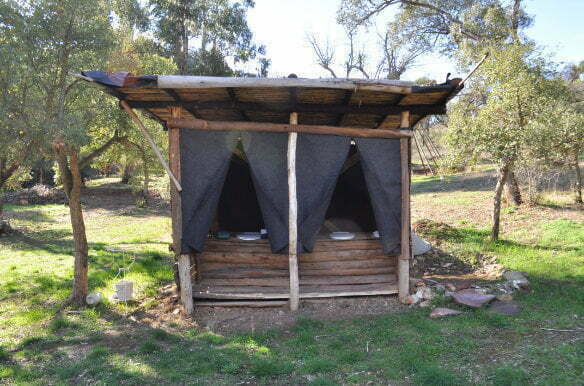
In the case of models with collection containers as well as those with integrated composters, the use of the toilets ultimately hardly differs from that of a conventional toilet. Both the sitting position and the performance of the ‘business’ are identical. The flush is the only thing that is missing since an excess of liquid would disturb the composting process or would completely prevent it. Instead, litter is added to the excretions. Although this may be somewhat unusual when first using such a toilet, it has both financial and environmental benefits: water is a precious commodity and the waterless operation of the toilet not only saves water entirely, but also doesn’t require complex reprocessing. What’s more, the acquisition costs of the composting toilet are neutralised within a short time.
The litter used serves a faster drying as well as the odour retention and minimisation of the resulting excretions. At the same time, the moisture is regulated in the collecting container which is beneficial to the composting process. Since the excretions are collected in a single container, however, a large amount of litter is required after going to the toilet in order to be able to bind the urine completely. In addition, the amount of litter needed exceeds that used in alternative toilet systems, such as the TROBOLO composting toilets, many times over. Suitable litter materials are bark mulch, sawdust or similar cellulosic material. Even uncontaminated (toilet) paper can be safely added. Thanks to litter and exhaust air, the odour formation is successfully reduced which makes the composting toilet not only a water- and energy-saving, but also a hygienic alternative to the conventional toilet. Finally, the finished compost soil can be used as fertiliser for ornamental plant beds and thus returned to nature.
The necessary accessories of a composting toilet are, despite the different models, essentially the same. An indispensable component of all model designs is the litter to bind the emerging moisture of the excretions and to prevent odours. Models with an electric exhaust system or other electrical devices, such as stirring units, etc., also need a respective connection.
The disposal of the excretions is different depending on the model. Composting toilets without built-in composters rely on an external composting facility into which the collected waste including litter can be emptied. For composting that is as efficient as possible, a closed fast composter is recommended. However, a conventional compost pile is also suitable. For this, the excretions should be allowed to rest for at least 24 months to ensure that it is completely composted – you can still add other biological waste from the garden and kitchen, though. Finally, to avoid any washing out by rainwater, a cover in the form of a tarpaulin or the like is recommended.
In the case of models with an integrated composter, the finished compost can be taken directly from the toilet – after a rest period of at least two years – and used to fertilise ornamental areas, flowers, trees and shrubs.
Finally, the cleaning of a composting toilet differs only slightly from that of a conventional toilet. Thanks to the waterless operation, toilet brushes and cleaning agents are not required at any time. Externally, not much more cleaning is needed as in the case of regular toilets either as these differ only slightly in appearance and use and the cleaning effort is generally limited to wiping the seating surface with a damp cloth. Finally, the cleaning of the composter is unnecessary because of its function as decomposition and fermentation equipment.
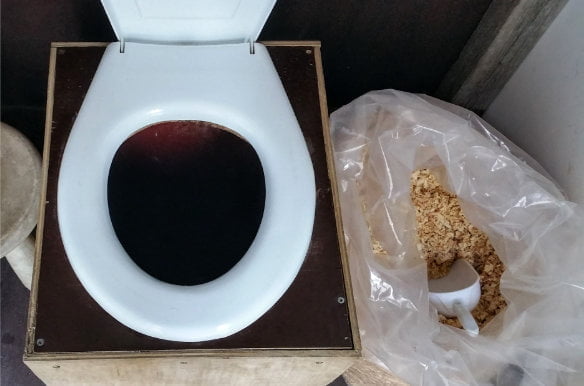
Composting toilets are generally suitable both for indoor and outdoor use: however, the model design is ultimately the deciding factor when choosing the respective location. Toilets with an integrated composter cannot be set up as flexibly as models with a smaller collection container due to the large reactor volume. If enough space is available, however, this type of composting toilet can also be used indoors. Thanks to their waterless operating principle, composting toilets are also particularly suitable for areas of application which have no connection to the sewage system. As a result, they are ideal for allotments, golf courses, dog training grounds, nurseries or riding stables, but also weekend or holiday homes are suitable locations. If the models rely on electrical exhaust systems or other electrical accessories, such as stirring units or heating rods, an existing power connection is a necessary requirement.

The preceding explanations illustrate that the different models and versions of composting toilets offer far more than the possibility of implementing ecological and autonomous lifestyles. Rather, they are a cost-effective and, above all, hygienic alternative to the conventional toilet in the long run. In the following, we will conclusively compare the different benefits and disadvantages.
Sign up for our newsletter here to never miss out on any news or free promotions.
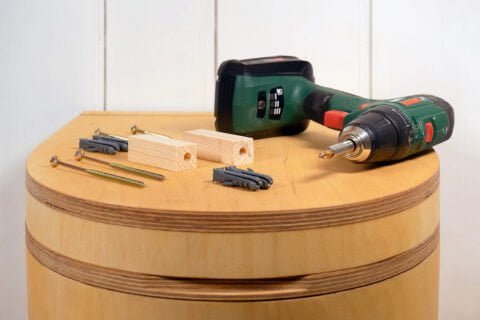
"Do-it-yourself" is the latest trend, so it's not surprising that more and more people want to build their composting toilet themselves. But how does that actually work? In this article, we take a closer look at the topic and give you numerous tips and tricks to make your do-it-yourself project a success. Have fun!
Read more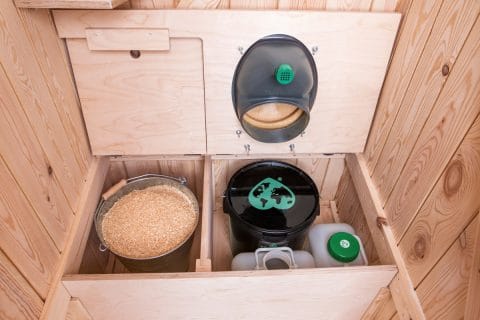
Below you will find information on functionality, areas of application as well as advantages and disadvantages of separating and dry toilets.
Read more
In this guide, you will find information about the functionality, areas of application as well as the benefits and disadvantages of chemical toilets.
Read more¡Tenemos buenas noticias! Aunque gran parte de nuestro contenido todavía esté en inglés, ya hacemos envíos a tu país. Solo tienes que hacer el pedido y los productos te llegarán directamente a casa.
De acuerdoBuone notizie! Anche se la maggior parte dei nostri contenuti è ancora in inglese, spediamo già nel tuo paese. Fai un ordine e ricevi i prodotti direttamente a casa tua.
D'accordoVi har gode nyheder! Selvom det meste af vores indhold stadig er på engelsk, sender vi nu til dit land. Du skal bare afgive din ordre, så bliver produkterne leveret direkte hjem til dig.
ForståetWe hebben goed nieuws! Hoewel het meeste van onze inhoud nog steeds in het Engels is, verzenden we nu naar uw land. Plaats uw bestelling en de producten worden direct bij u thuisbezorgd.
BegrepenYou are currently viewing a placeholder content from Facebook. To access the actual content, click the button below. Please note that doing so will share data with third-party providers.
More Information